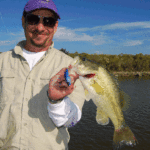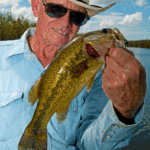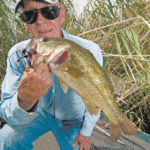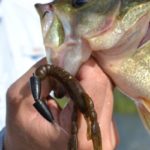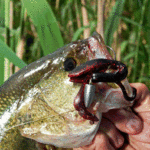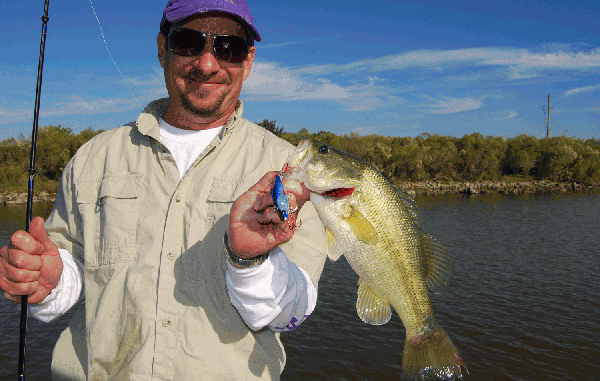
This time of year, you don’t have to be a good freshwater angler to catch all the bass you want out of Venice.
Jonathan Ryan is an avid speckled-trout angler.
The perfect day for him is finding some new honey hole in what’s left of the Delacroix marsh, and throwing double-rigged Hybrids to specks that are on Jenny Craig’s new plastic-only diet.
The breadth of his bass-fishing experience just about equals his time spent walking on the moon. When he was a youngster, he made a few trips to his uncle’s stocked pond, where he caught some bass off a pier.
That’s it.
He probably won’t be the next Kevin VanDam.
So Ryan wasn’t entirely sure what to expect when he made his first Venice bass trip in mid July.
As anyone who follows the river stages knows, the Mississippi fell like a smooth stone early this year, ironic because only 12 months earlier it set records for height. By mid June, the river was holding below 3 feet at New Orleans’ Carrollton gauge, and the water even that far north had turned a beautiful, translucent green.
Farther south, near the toes of the bird-foot delta, the water by July got prettier than most locals had seen in many years, possibly even decades. There are times when winds die during the months of May and June, before the temperatures are hot enough to cause algae blooms, when the waters in Timbalier, Terrebonne and Barataria bays gets crystal-clear. It still has a green tinge, but visibility is stunning, and anglers regularly watch speckled-trout swim out of wellheads to hit their baits.
If you’ve ever seen that then you know how the Mississippi looked this summer.
It was so clear that many of the guide boats actually took their clients to drift with the current and sight-cast to redfish. In the Mississippi. Ol’ Man River. The Big Muddy.
The river is almost always low and pretty in September and October, but in July? Not usually. That’s the month when the river might first fall below 5 feet at Carrollton, and the first tendrils of green show up in anglers’ prop wash as they’re motoring to their hotspots.
Diehard bass anglers, the guys who beat the banks all year in the Basin, Lake Verret and the hundreds of lakes that dot the Louisiana landscape, first turn their attention to Venice around the time when everyone’s wishing America a happy birthday.
The fishing is less than ideal because the water’s usually still a little off and the temperatures are so stinkin’ hot. There are many blazing summer days when bass would rather sit in the shade drinking lemonade than go through the hassle of chasing a bouncing piece of plastic.
But when the river gets low and slow and perfect — even in July — the Venice-bass brigade hitches up its bay boats, flat boats and even a few bass boats. These aren’t the guys who fish bass across the state every weekend. In fact, most of the year, these guys would rather attend a knitting class than have to fish bass.
They’re attuned to the fast action of specks at the rigs or redfish in the ponds, and don’t have the patience to target persnickety largemouths.
But Venice bass aren’t like other bass. For one thing, they’re about as selective about what they’ll eat as Adam Richman. While bass in other areas won’t hit a crankbait with four stripes on days when they want three stripes, Venice bass are either too dumb or hungry to give a damn.
Secondly, Venice bass spend much of the year in the protective cover of acres and acres of roseau canes, where they grow fat as footballs feeding on crawfish, shad, shrimp, snakes and anything else they can get their wide mouths around.
When the river falls, they get pulled from their hideouts, and have no place to go but the edges of the marsh, where they congregate in numbers that seem almost unimaginable.
So the fish are big, dumb and they stack up like cordwood after a summer storm. It’s all too much for the Venice-bass brigade to resist.
Ryan’s trip was with a buddy who proudly counts himself among the Venice-bass brigade. He couldn’t care less about “green trout” during the rest of the year, but when the river gets below 4 feet and stays there, he’s quite familiar with the crazy-fast action that awaits in the major and minor passes south of Venice.
So they surveyed the tides, picked a date on the calendar with favorable conditions and made their way down Highway 23.
The first and only stop of the day was in Delta Duck, a series of canals that haven’t yet succumbed to the wholesale erosion the area has seen in recent years. The Delta Duck field features ponds that spill into canals with steep banks — perfect bass habitat.
There are many ways to catch Venice bass this time of year, but perhaps the most thrilling method is to flip soft-plastics along the roseau canes. When an angler feels a fish and sets the hook, he is greeted by a shower of river water as the fish fights for its freedom within inches of the boat.
That’s the technique Ryan and his buddy were using, dropping redbug french fries and green-pumpkin Zman crawfish impaled on worm hooks under doubled 1/4-ounce bullet weights.
Although his buddy caught the first several fish, it didn’t take Ryan long to determine what constituted a bass bite, and that he had to set the hook harder than a lumberjack swinging up his axe.
Within minutes, he was yanking 1- to 2-pound bass into the boat, and a new member was added to the Venice-bass brigade.
Many others are being added by the day, according to Capt. Chris Wilson.
“The bass fishing is off the chain,” he said. “It’s not hard at all to catch all the bass you want.”
Wilson and the rest of the charter fleet have been running into copious amounts of bass while fishing for redfish in the major and minor passes. The action is so good that, whether you target them or not, you’re going to catch some bass.
“It’s a combination of a bunch of factors,” Wilson said. “That high river last year protected a lot of the fish because you couldn’t really get to them.”
Also, Wilson said, all that fresh water allowed grass to spring up in the ponds, and that gave the fish lots of desirable nursery habitat, where they could grow quickly and get that classic Venice-bass football shape.
The recent stifling heat, however, has caused the fish to pull out of shallow ponds and their bathtub-warm water and into the passes, where the moving water stays cooler.
The easiest way to catch them, Wilson said, is to throw crankbaits and spinnerbaits on points in the passes. Really, anything that breaks the current will hold fish.
Anglers who like the thrill of flipping and pitching are catching plenty of fish just working the canes and hyacinth patches along the passes, Wilson said.
That’s precisely the way St. Gabriel angler Eric Williamson likes to fish them. He’s a year-round bass fisherman, but he summarily ignores the Venice area until the river falls and stays down.
“It’s got to be static below 4 (feet) for two or three weeks,” he said.
When Williamson sees the gauge get that low, he picks a day with the right tides and calls in sick for his first Venice bass trip of the year.
“The fishing is best the last three hours prior to the low tide,” he said. “Lately, I’ve determined that when the water’s this pretty, you can catch them on any part of the fall(ing tide), but the last three hours are optimum.”
Williamson said he’s had numerous occasions when he’s struggled on a particular canal bank only to return later and find the place overloaded with bass that hit on every drop. The tide is that important.
Williamson flips the canes with red shad and redbug Speed Craws below 3/8-ounce bullet weights.
“I like the lightest weight I can get away with,” he said.
That’s a very important element, he said. In fact, on a recent trip, Williamson took along a buddy who’s a good bass fisherman. Williamson was using his 3/8-ounce weight while his friend had a heavy punching weight.
Williamson put the first 12 bass in the boat before the other angler went with the lighter weight and began holding pace with Williamson.
The veteran Venice angler does switch to a heavier weight when he runs across canals lined with hyacinths. The floating plants provide shade and cover for bass, so they are ultra-productive, but it takes some weight to get through them.
The extra effort is worth it. Few things are more fun than seeing a 4- or 5-pound bass explode under the hyacinths after he realizes he’s been fooled.
When picking canals to fish, Williamson always looks for pretty water pulling out of the canes. When he finds that, he focuses on the first 75 yards of the canal from an intersection.
“I don’t even fish the long stretches, especially when it’s warm,” he said.
Williamson will be towing his Champion bay boat down to Venice every chance he gets for at least the next couple of months. But as with everything, Venice bass fishing has a shelf life.
“It’s over as soon as you get the first sign of a rise in the river,” he said. “Last year, it jumped above 5, and I thought I could get a quick trip in, but I didn’t get a bite. It was over.”
But until that day arrives, lots of new members will be added to the Venice bass brigade.
